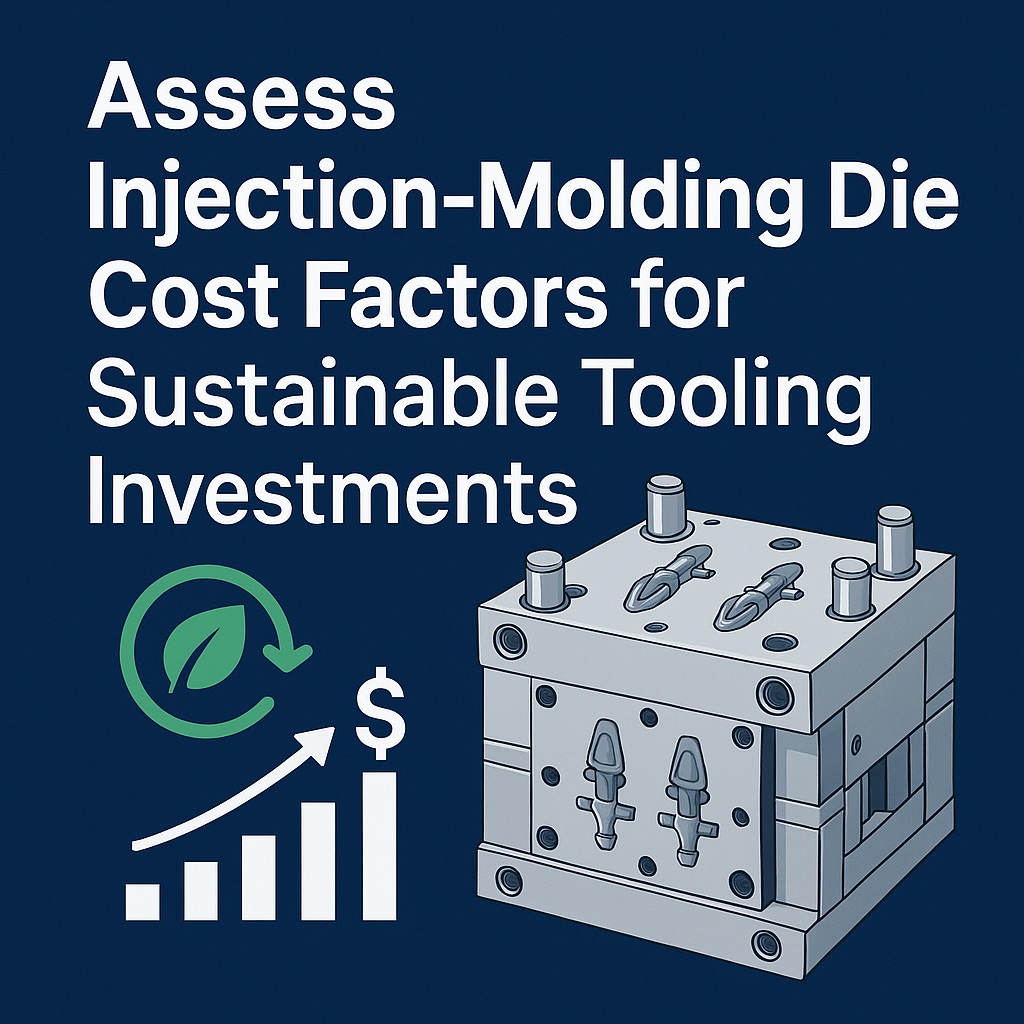Assess Injection-Molding Die Cost Factors for Sustainable Tooling Investments
Assess Injection-Molding Die Cost Factors for Sustainable Tooling Investments
Early insight into tooling economics is the single biggest lever you have to control unit cost, launch timing, and environmental impact. Before you approve a purchase order for a new mold—or transfer an aging tool—it pays to look beyond up-front price tags and quantify the total cost of ownership (TCO) over the tool’s entire service life.
1 Break Down Die Cost into Four Core Buckets
| Cost Bucket | Typical Share of Up-Front Price | Long-Term Impact | Key Levers |
|---|---|---|---|
| Steel & Base Materials | 40 – 60 % | Durability, repair cycles, scrap rate | Choose H13/S136 for >1 M cycles; use aluminum 7075 or NAK80 for pilot runs |
| Machining & EDM Hours | 20 – 30 % | Lead time, cavity accuracy | Consolidate electrodes, add conformal cooling via 3D-printed inserts |
| Hot-Runner / Valve System | 10 – 25 % | Cycle time, color change waste | Invest in servo-valve hot runners to cut gate vestige and resin purges |
| Design & Program Management | 5 – 10 % | Future ECO cost, documentation quality | Digital twin + DFM eliminates re‐cuts, supports remote FAT/PPAP |
Rule of thumb: A mold that costs 20 % more up front but runs 30 % faster or lasts 2× longer yields the lowest TCO—and the smallest carbon footprint.
2 Seven Hidden Drivers that Inflate—or Shrink—Tooling TCO
-
Cavity Count vs. Forecast Volumes
Under-cavitation forces extra shifts; over-cavitation wastes steel and energy. Aim for < 1-year payback on incremental cavities. -
Parting-Line & Slide Complexity
Every lifter adds machining hours, leak-risk, and preventive-maintenance labor. Redesign snap-fits or vent holes to avoid side actions. -
Surface Finish & Texturing
A-Class polish on hidden ribs is sunk cost. Specify SPI-C or VDI textures only where cosmetics matter. -
Cooling Channel Design
Conformal channels can drop cycle time 20–40 %, slashing per-part energy use. -
Smart Sensors
Cavity-pressure transducers cost a few hundred dollars but prevent thousands in scrap and downtime. -
Material Selection
Regrind-tolerant resins and bio-based plastics may need hardened gate inserts or corrosion-resistant S136 steel—plan early. -
Tool Relocation & End-of-Life Recycling
Modular base plates and standard clamp slots ease transfers; recyclable aluminum lowers disposal impact.
3 Sustainability: Think Carbon per Part, Not Just Dollars per Cavity
| Design Decision | Carbon Impact | Financial Outcome |
|---|---|---|
| Conformal Cooling | –15 kg CO₂ eq. per 10 k parts by cutting cycle time 25 % | Tool pays back premium by 120 k shots |
| Hot Runner vs. Cold Runner | –4 kg CO₂ eq. per 10 k parts; eliminates sprue regrind | Saves 2–5 % resin cost at >50 k shots |
| High-Hardness Core Pins | –30 % downtime for refurb | Raises tool life from 800 k to 1.6 M shots |
4 ROI Model: Steel vs. Aluminum Bridge Tool
| Metric | Al 7075 Bridge Tool | H13 Production Tool |
|---|---|---|
| Up-Front Cost | US $7 500 | US $28 000 |
| Cycle Time | 32 s | 24 s |
| Life Expectancy | 25 k shots | 1 000 k+ shots |
| Carbon Footprint / Tool | 110 kg CO₂ eq. | 550 kg CO₂ eq. |
| Break-Even Volume* | — | ≥ 85 k parts |
*Total manufacturing cost per part (tool amortization + machine time + energy)
Takeaway: Use aluminum for EVT/DVT runs, then roll a bridge-tool credit into steel for mass production—an option baked into every quote from TaiwanMoldMaker.com.
5 Checklist for a Sustainable Tooling RFQ
-
Lifetime Volume & Ramp Rate (prototype, pilot, mass)
-
Resin & Additives (glass, flame retardant, recyclate %)
-
Tightest CTQs (flatness, CpK targets, cosmetics)
-
Cycle-Time Goal (seconds, not “as fast as possible”)
-
Traceability Needs (sensor count, MES API)
-
Carbon or ESG Metrics (E-PDs, scrap limits)
-
Re-Use Strategy (family inserts, modular base, global transfers)
6 How TaiwanMoldMaker.com Maximizes Your Tooling Investment
| Pain Point | Our Solution |
|---|---|
| Up-front cost vs. longevity | Dual-path pricing—aluminum bridge + steel production tool in one quote |
| Lead-time pressure | 48-Hour DFM Pack & rapid EDM cells; T-0 parts in ≤ 3 weeks |
| Energy & carbon targets | Conformal-cooled inserts, high-OEE hot‐runner cells, MES dashboards |
| Future design changes | Modular cavity inserts engineered for quick swap |
| Multi-material programs | Two-shot & over‐mold tooling integrated with sustainability scoring |
Explore Services & Real-World Proof
-
✔️ Custom Mold and Design Maker – DFM, Moldflow, and carbon-footprint modeling
-
✔️ Mold Service – Concept-to-steel turnkey builds
-
✔️ Injection Mold – High-cavity, hot-runner systems for mass production
-
✔️ Molding – Pilot or series production with live energy tracking
-
✔️ Customer Examples – Case studies showing double-digit tool ROI and carbon savings
7 Next Steps: Quantify Your Sustainable Tool ROI
-
Upload CAD & volume forecast—prototype through end-of-life.
-
Request a free Tooling TCO Model—shows per-part dollars and kg CO₂ eq. over five years.
-
Approve the path that meets both budget and ESG goals—and see first shots in as little as three weeks.
Ready to invest in tooling that pays dividends for years—and for the planet?
Get your no-obligation sustainable tooling proposal from TaiwanMoldMaker.com within 48 hours.









